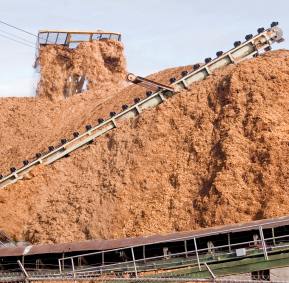|
|
 |
2009 FUEL WOOD PRICES |

Fuel-wood prices varied by region in 2009. According to Forest2Market's Delivered Price Benchmark, the only pricing service in the South and Pacific Northwest based on transaction data, prices for fuel-wood increased in the South and decreased in the Pacific Northwest. Across the South, fuel-wood prices averaged $20.98 per green ton, and in the Pacific Northwest, wood fuel prices averaged $44.08 per dry ton. More... |
 |
POLICY FOCUS: BIOFUELS |
|
When the Biofuels Tax Credit of $1.00 per gallon expired at the end of 2009, some biofuels producers discontinued production. Many of the rest are struggling to stay afloat. Into this environment, President Obama announced a comprehensive and multi-pronged approach to achieving revised renewable fuel standards (RFS2) with biofuels.
RFS2 Implementation Rules
RFS2 standards were set by Congress in the Energy Independence and Security Act (EISA). Proposed rules were released in May 2009, and in early February, the EPA announced the long-awaited rules for meeting RFS2. Significant changes were made for the final rules. Biomass Crop Assistance Program (BCAP) Proposed Rules
In order to establish a biomass supply chain and make sure the supply is going to facilities that will increase the amount of renewable energy produced in the US, the USDA announced a revised set of rules for BCAP's Collection, Harvest, Storage and Transportation (CHST) matching payments program. In order to accomplish the program's intent, the new rules propose changes to the structure of how payments are made. An Umbrella Policy for Coordination and Accountability
|
 |
BREAKING GROUND: |
Site Selection and Project Bankability
With the Biofuels Policy announcements made in early February, the U.S. governement has demonstrated it is serious about replacing oil with domestic and renewable sources of transportation fuel. This policy as well as others already underway will undoubtedly provide the focus and investments needed to increase the number of proven technologies for turning wood into energy. More industries, schools and government buildings will generate their own power, more utility companies and independent producers will generate electricity for the grid, more wood pellet manufacturers will serve domestic residential and industrial markets and international markets, and more biodiesel, cellulosic ethanol and other bioproducts producers will arrive on the scene.
We will continue to see a significant increase in the number of operational wood bioenergy facilities over the next five years. As this growth occurs, it is almost certain that competition for wood fiber will intensify in local supply sheds.
|
 |
2009 WOOD PELLET PRODUCTION |
Outstrips Demand in the Pacific Northwest
Despite all the announcements, demand for wood pellets in 2009 was well below both manufacturing capacity and production levels in the Pacific Northwest. As a result, prices for sawdust and shavings (the raw materials used by pellet manufacturers) moved off their 2008 highs.
Higher heating costs and a robust European market led to strong gains for the pellet industry throughout most of the last decade. According to a June 2009 report by the USDA, wood pellet capacity in North America increased from 1.2 million tons in 2003 to 4.6 million tons in 2008. (Note: All volumes have been converted from metric tonnes--the unit of measurement used by the USDA--to U.S. short tons.)
|
 |
BIOBITS |
|
Range Fuels, long the great hope for the wood-based cellulosic ethanol industry, expects to start up gradually in the second quarter of 2010. According to the EPA, despite $150 million in federal grants and loan guarantees and anticipation that the facility would produce 10 million gallons of fuel in 2010, they are now expected to produce only a quarter of that total. See article in the Washington Post. |
 |
FOREST2MARKET CELEBRATES 10-YEAR ANNIVERSARY |
|
In January, Forest2Market celebrated its 10th Anniversary. Marking this occasion, Pete Stewart said, "To a large degree, our success can be traced to an obsession with real data. I spent the first decade of my career buying or selling timber and timberland without reliable data on its value. The idea for Forest2Market originated there, and we have been offering solutions to industry participants built on real market data ever since. To this day, every business solution we develop, every piece of industry information or analysis we provide to our clients is based on transaction-level data and a commitment to provide our clients with accurate and actionable business information." | |
|
|
|